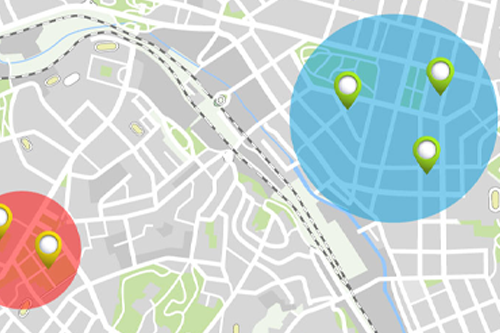
Understanding customers is one of the first steps toward better connecting with and serving them. Being able to personalize marketing efforts to those customers is taking it a step further. There are many tools available to assist with this process. Location data is one of the more valuable tools as it tells businesses where their customers are so they can adjust messaging and create more relevant content to reach their customers in the right place at the right time.
Geotargeting and geofencing are two marketing tactics that utilize location data. While these two terms seem similar and could be easily confused, they are not interchangeable.
Geotargeting Vs. Geofencing
Geotargeting relates to the ability to deliver content to customers who fit into an audience based on where they live or work (zip code, city, state or even country) and can assist with expanding into new market areas. A good example would be an installation or security company who serves several counties neighboring their home office. By using geotargeting, the company can reach out to their target audience, whether consumer or business, within those counties and attract customers who are more likely to purchase their service because they are conveniently located and can offer faster service. Location data can be gathered by either having a prospect enter their information into a form or by using their browser data such as their IP address.
Geofencing, by comparison, serves customers in a unique location by targeting customers based on a virtual fence drawn around a certain area like a store or venue. When a customer enters this area, they can be sent an offer or message targeted around a product or service. This is done through use of GPS technology that triggers a set of actions once someone enters the “fence”. Burger King used this tactic successfully in its 2018 “Whopper Detour” campaign by offering a Whopper for a penny if users went within 600 feet of a McDonalds.
Geotargeting is more personalized as it focuses on specific areas and factors in a customer’s interests, behaviors and demographics to further brand awareness and create chances for higher conversions in the future. Geofencing is helpful for reaching a broader demographic audience in a perimeter-based target area and can help businesses increase sales through increased conversions. By using both together, business owners can work with this data to better understand their customers and grow their revenues.
Benefits of Using Geotargeting and Geofencing in Your Marketing Campaigns
If you are looking to expand your marketing tactics to reach a more targeted audience, here are three advantages to adopting geotargeting and geofencing into your marketing plan.
Advantage 1: Boosts ROI and Increases Sales
Having the right parameters for your location-based efforts can greatly improve your ROI. Geotargeting gives your business the ability to create specific targets within its overall target audience to push advertising to that group, reducing waste in your marketing budget. Geofencing can use this set of parameters to drive traffic to your store, booth or any other physical location by pushing out content only to those within a set target area, creating curiosity about a promotion or offer.
Advantage 2: Expands Business by Reaching New Customers
Crafting and using the right message at the right time is necessary to get in front of potential customers. For instance, if your business has a physical location or store and you want to expand its reach, geotargeting can be used to reach out to new targeted customers within another region. If you know your audience, you can use that information to connect with prospects with similar interests in a nearby city or county and secure new customers. A business can also utilize geofencing to drive traffic to a trade show booth or event by putting a virtual fence around the event and push advertising messages or specials or inviting guests to stop by its display.
Advantage 3: Steer Customers Away from the Competition
Burger King’s “Whopper Detour” campaign was a clever way of steering customers away from buying Big Macs and toward purchasing Whoppers instead. You can implement similar tactics by using geofencing to create target areas around your competitors’ locations and send out messaging to bring potential customers to your location instead.
Although they may seem similar, geofencing and geotargeting are different sides of location-based marketing with different functions that can help accomplish similar goals. Learning how to best use both can help businesses expand their reach and stand strong against competition.

